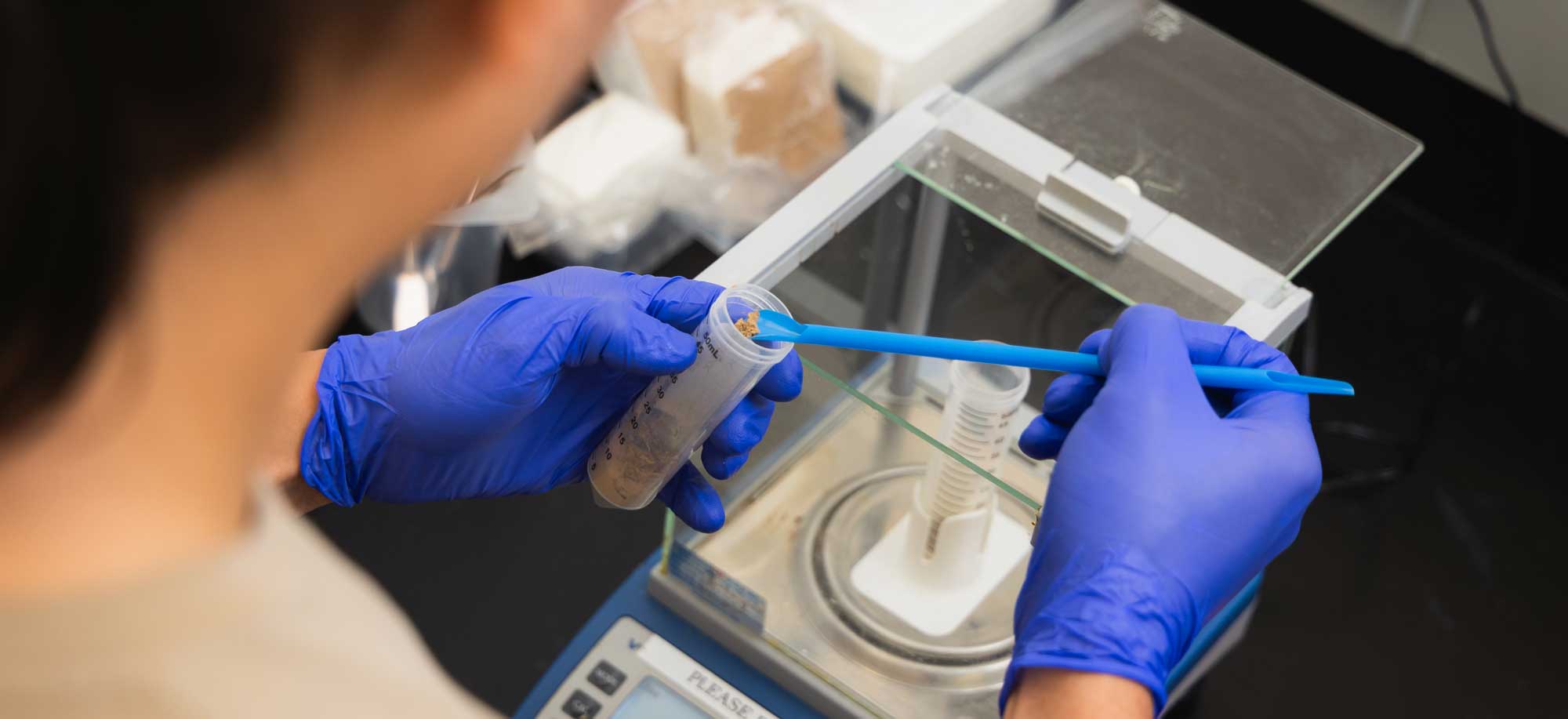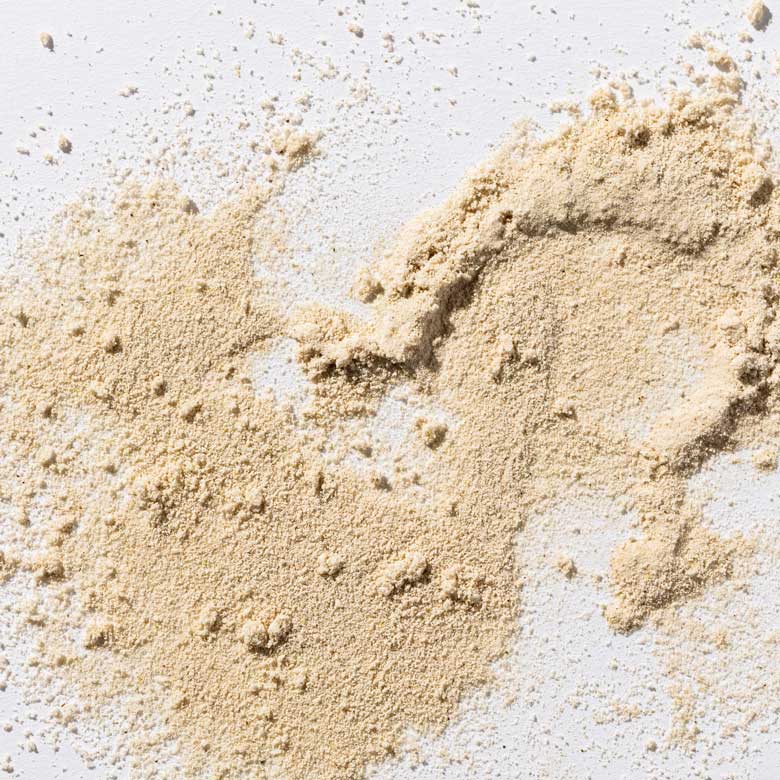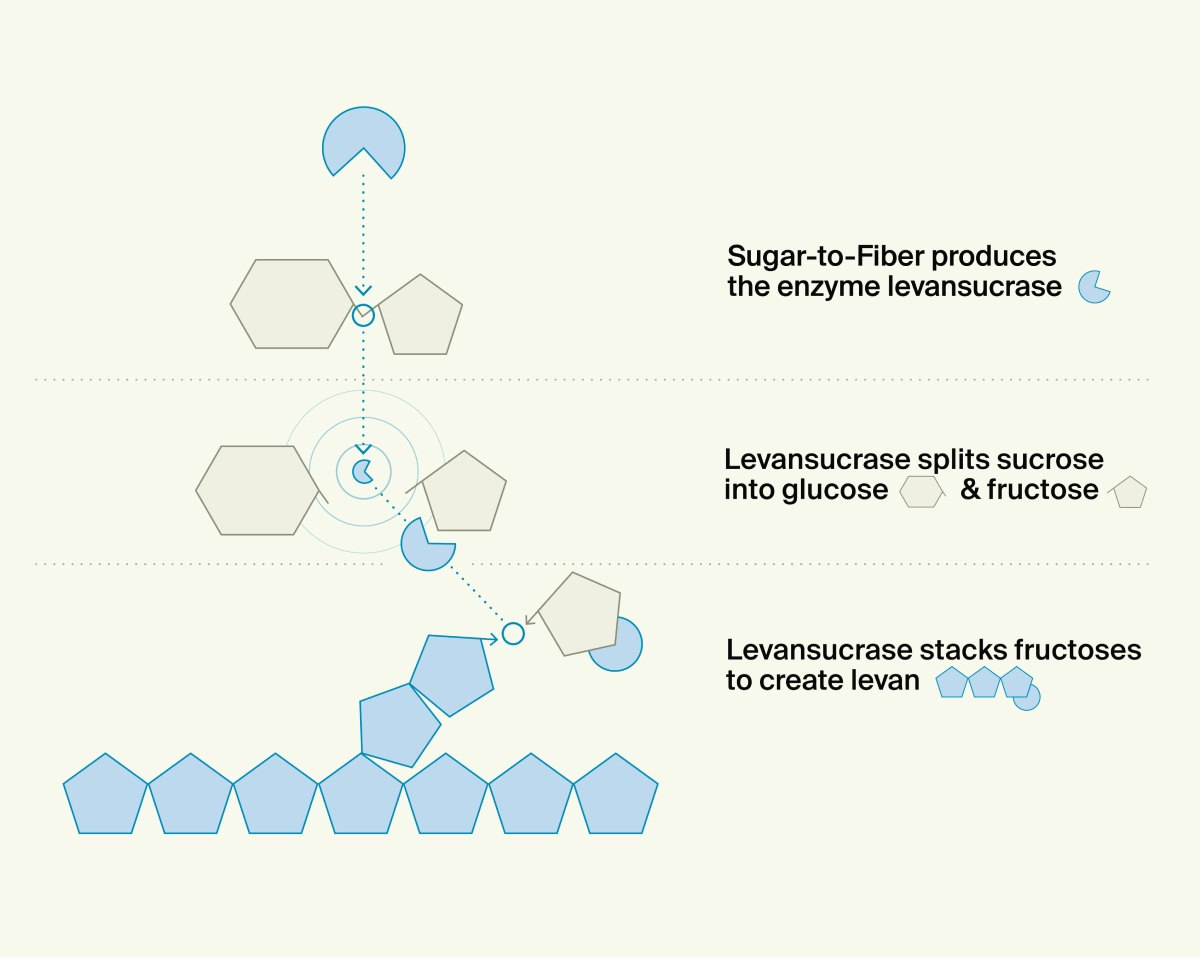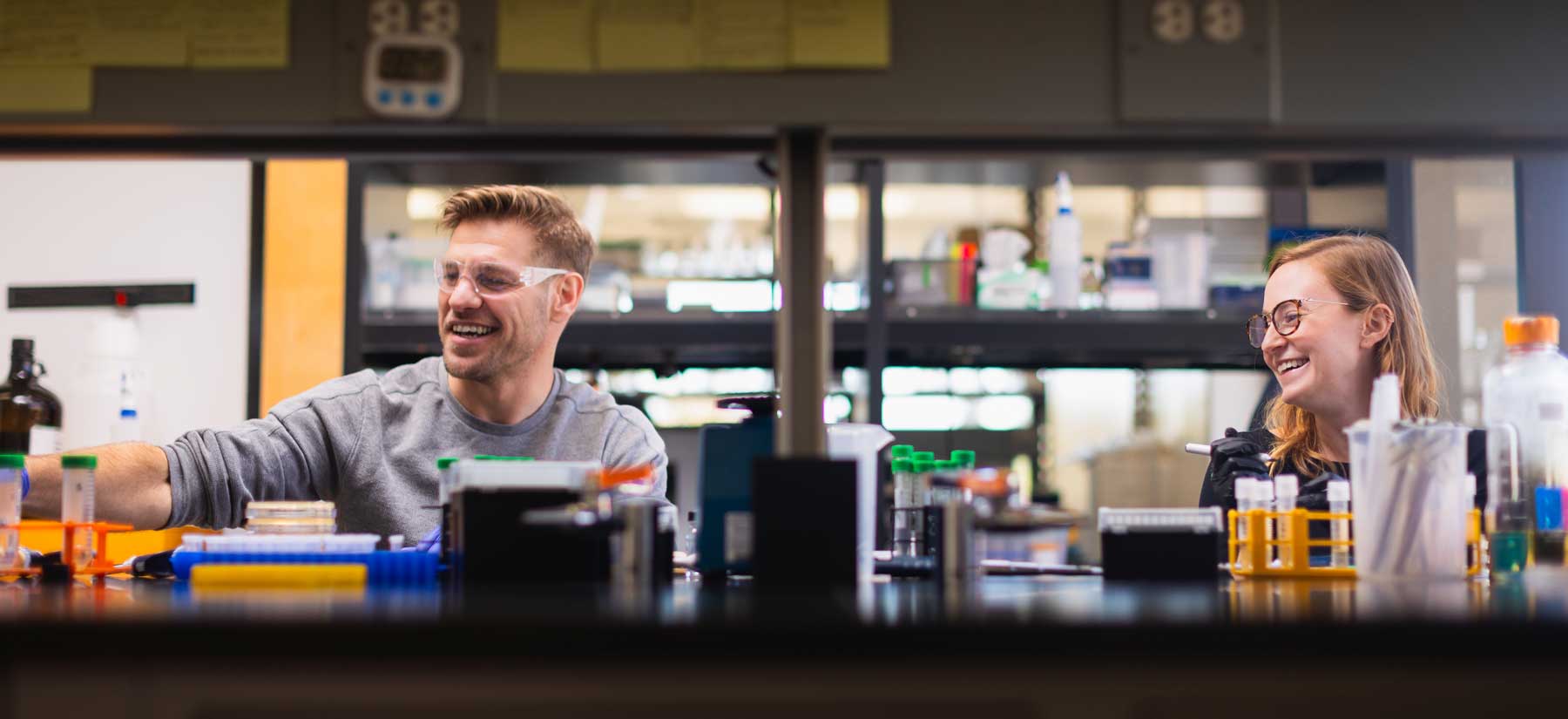Sugar-to-Fiber
A probiotic that turns sugar into fiber – built with genetic engineering by a team of microbiologists.
The Problem
We need more fiber
Fiber plays an important role in our health, but most of us aren’t getting enough fiber in our modern diets. We need 25-30 grams of fiber per day, but about 95% of us don’t meet that goal (citation). There are likely a few reasons why we don’t get enough fiber, and they vary from person to person. One big factor is the overall fiber content of many of the foods we consume. Processed foods (think white bread, pasta, etc.) are often convenient and accessible, but they tend to use refined grains, which have far less fiber than their whole-grain counterparts. It’s also not just about eating healthier. If you steer clear of processed foods you are likely still at risk of not meeting your daily fiber needs. It may seem obvious that ultra processed foods tend to be low in dietary fiber, but did you know that popular, seemingly healthy food trends also make it difficult to get enough fiber in your diet? Notably, carb-reducing, gluten-free and keto diets are notorious for low fiber intake. Regardless of what you eat, it’s unlikely that any of us will meet the recommended daily dose of fiber. It takes a true concerted effort to include fiber rich foods in our diets.


We need more diverse fibers
The story isn’t just about more fiber. There are actually many different types of dietary fibers that provide varying health benefits. Important characteristics include whether or not a fiber is soluble and whether or not a fiber is fermentable. When a fiber is insoluble (does not dissolve in water) it acts as a bulking agent, speeding up the rate of digestion, whereas a soluble fiber tends to dissolve into a gel-like substance that actually slows down the rate of digestion. Insoluble fibers play a role in bowel regularity and easing constipation, while soluble fibers provide benefits such as increased nutrient absorption and lowered cholesterol. Soluble fibers can also be fermentable, meaning that they feed the gut microbiome, a complex ecosystem of microbes that impact everything from our gastrointestinal health to our mental health. We also call fermentable fibers ‘prebiotics’ because they support a healthy and balanced gut microbiome.
It’s clear that there are many benefits to fibers in our diet, so when we say we aren’t getting enough it means two things:
- We need more total fiber.
- We need more fiber diversity.
While it takes effort to get more fiber in our diet, it takes even more effort to make sure we get a diversity of fiber types.
The Solution
We eat plenty of sugar but not enough fiber
While we don’t get enough fiber, the modern diet tends to provide us with an excess of sugar. So what if we use that sugar to make more fiber? Because fiber molecules are just long chains of sugar, that’s easier to do than you’d think! Chemically speaking, sugars and fibers are both carbohydrates—also known as saccharides. The difference between them is how many molecular building blocks make up the final product. Sugars are either a single building block (monosaccharide) or 2 building blocks linked together (disaccharides). Table sugar (sucrose)—the sugar found in your pantry and in many of the fruits, vegetables, and nuts we consume—is a disaccharide. It is made up of 2 building blocks: 1 glucose and 1 fructose. Fibers, on the other hand, are made up of 10 or more molecules (polysaccharides). For example, cellulose—the fiber found in leafy greens—is made up of many individual glucose molecules chained together.
Our scientists understood that the building blocks of sugar and the building blocks of fiber are the same. So we asked ourselves, “Is there a way to convert some of the sugar we consume into the fiber that we need?” The answer we came up with is the unique ingredient in Sugar-to-Fiber: our proprietary probiotic, Bacillus subtilis ZB423™ (“ZB423™).
Introducing Bacillus subtilis ZB423™, the key ingredient in Sugar-to-Fiber
Using genetic engineering, our team of PhD microbiologists took a normal probiotic bacteria you likely eat every day (the species Bacillus subtilis) and engineered it to convert sugar into fiber steadily throughout the day. The resulting probiotic bacteria is ZB423™.
The DNA we introduced into ZB423™ enables this unique probiotic to produce levansucrase, a functional molecule (enzyme) that can do two important actions:
- Break apart table sugar (sucrose) into its molecular building blocks (glucose and fructose)
- Reroute the fructose and use it to build a rare fiber called levan.
The production of levansucrase by ZB423™ literally turns sugar (sucrose) into fiber (levan). And just like our Pre-Alcohol probiotic (ZB183™), this engineered bacteria can deliver that particularly useful enzyme directly to where it is needed most: the gut. Also, by using a probiotic, we enable the conversion of sugar into fiber slowly throughout the day. This maximizes the benefit in the body and delivers the fiber in a way that your microbiome prefers, rather than all at once.
- Break apart table sugar (sucrose) into its individual sugars (glucose and fructose)
- Reroute the fructose and use it to build a rare fiber called levan.
This probiotic is engineered to literally turn sugar (sucrose) into fiber (levan). As with our Pre-Alcohol probiotic, we engineered a bacteria to deliver an enzyme directly to where it is needed most. Also - by using a probiotic bacteria to deliver levansucrase, it can convert sugar into fiber slowly throughout the day. This maximizes the benefit in the body and delivers the fiber in a way that your microbiome prefers.

Sugar-to-Fiber is engineered to make a rare, prebiotic fiber called levan
As mentioned above, the levansucrase builds a fiber called levan. Levan is a fructan, which means it is a fiber made up of fructose molecules. So when we say it reroutes fructose, that is because it can literally pull fructose away from sucrose and chain it with other fructose molecules until they build a fiber.
But why levan? First of all, this fiber is highly fermentable, so it can be used as food for the other microbes in your gut. This makes levan a prebiotic— able to support a healthy gut microbiome. Second, levan is a soluble fiber, and we know soluble fibers support our overall health. Third, levan is not very accessible in a Western diet. It is more common in other countries like Japan where dishes like natto (fermented soybeans) are a good source of levan. Because we don’t consume much of it, adding a source of levan production to your gut inherently increases the diversity of fiber you are consuming. When we consume diverse fermentable fibers, we also encourage a diverse or balanced gut microbiome! You can read more about that in our previous blog article, where we explain the importance of supporting the gut microbiome with a diversity of fibers.
The Result: your body gets more of what it needs and less of what it doesn’t, creating a path to gut health from the foods you already eat that wasn’t possible before Sugar-to-Fiber.
Data & Validation
Our engineered probiotic has been tested in the lab for safety and functionality
As with our Pre-Alcohol probiotic ZB183™, once ZB423™ was built, we needed to ensure that it was safe and that it worked as intended.
Safety
We subjected ZB423™ to years of laboratory testing and review by America’s top food toxicologists, the results of which confirmed it to be completely safe and FDA-compliant. The data from these tests has been published in the peer-reviewed Journal of Applied Toxicology.
Now that we have confirmed our genetically engineered probiotic is safe and works as intended, we make sure this is true of every batch. Sugar-to-Fiber undergoes rigorous quality testing at every stage, from probiotic biomass to the final product, ensuring safety, purity, and efficacy. We transparently publish our standards for each test on our Quality page which can be found here.

Functionality
To confirm that ZB423™ worked as intended, we tested its ability to make levansucrase, break down sucrose, and produce levan. Over a series of laboratory tests where we compared it to the unedited B. subtilis strain, we confirmed that ZB423™ was highly effective at breaking down sucrose using expressed levansucrase and converting the fructose molecules into levan fiber.
One of the tests we ran was our levansucrase activity assay, which mixes sucrose and ZB423™ to show the activity of ZB423™-produced levansucrase. You can see that after twenty minutes there is a significant decrease in sucrose, combined with an increase in free glucose. As a reminder, the levansucrase enzyme cleaves sucrose into glucose and fructose, and then stacks the fructoses together to make levan fiber. This leaves the glucose free. To quantify the activity of the enzyme, we measure the amount of free glucose released over time after inputting a known quantity of sucrose. This free glucose is therefore a proxy for measuring levan fiber production.
As scientists we appreciate that every body is different and science is not one-size-fits-all. Even though we’ve proven that the product can reliably express the enzyme that converts sugar into fiber, that’s just the start. Over the ensuing months we will be publishing more data on how Sugar-to-Fiber works, hoping to share, to educate, and not to overwhelm. In the meantime, we thank you. By using Sugar-to-Fiber, you’re at the forefront of GMO technology, experiencing the benefits of cutting-edge science for yourself.
The road ahead
As we continue to explore the challenges of modern life, it’s clearer to us now more than ever that there is real need for a new generation of probiotics—built with purpose, based in science. And at ZBiotics, we are dedicated to bringing that next generation to you, and providing the information you need to decide whether you’d like to choose any of them to incorporate into your life.
Now for the first time ever, by adding Sugar-to-Fiber to our lineup you have more than one choice. There are now TWO genetically engineered probiotics on the market. So whether you already love us for Pre-Alcohol or you are trying us out for the first time with Sugar-to-Fiber, we are so excited for you to join us.

Founded by Scientists
Who are we? The very same people who did the research and built this technology: the ZBiotics team. We pride ourselves on the fact that we are a team founded and led with science at our core. Our technology is developed in-house by our own scientists in our own microbiology lab. This integrated approach allows us to create the best products available — products that marry cutting edge technology with innovative product design.
Our founder, CEO, and inventor of the primary technology underlying Pre-Alcohol is Dr. Zack Abbott. Zack’s background is as a microbiologist; he received his PhD in Microbiology & Immunology from the University of Michigan. After that, he worked designing clinical trials for biotechnology and pharmaceutical companies prior to starting ZBiotics to bring the idea of genetically engineered probiotics to the world.
To learn more, read about our founding story or meet the team.
You probably have some questions
Check out our FAQs to find answers to common questions and feel free to reach out if you have more.
When you mix Sugar-to-Fiber into your drink, the probiotic bacteria are naturally dormant and in a protective layer called the endospore (often simply just referred to as a spore). The bacteria in this spore form can travel safely through your stomach and make it to the intestines where they will wake up and start producing the enzyme (levansucrase) within a short period of time. After that, the enzyme is capable of breaking down the table sugar (sucrose) you consume into its two individual components: glucose and fructose. It then uses the free fructose to make levan, a rare and beneficial fiber that supports a healthy and diverse microbiome! After 18-24 hours most of our Sugar-to-Fiber bacteria will leave your body, so it’s best to take the probiotic daily to get a consistent benefit.
You likely haven’t heard of levan because it is so rare in western diets. It is what is called a fructooligosaccharide (fiber made up of fructose molecules) and is similar in composition to a very popular dietary fiber called inulin. While they are similar they have different structures, are processed differently, and can be preferred by different microbes in the gut. It’s not that levan is particularly special as a fiber all on its own, but because it’s harder to come by, adding it to your gut will inherently add fiber diversity to feed your gut microbiome. Fiber diversity is a critical element of maintaining a healthy and diverse microbiome, so having a product that increases the diversity of fiber in your gut is always valuable!
That’s great! And to be clear, nobody strictly speaking “needs” this. But Sugar-to-Fiber adds additional rare and beneficial fiber to your gut, and so it will be helpful to anyone, regardless of their diet. Sugar-to-Fiber converts table sugar (or sucrose) into levan, which is an uncommon dietary fiber that nourishes beneficial gut microbes and supports a balanced microbiome. Since it is almost certain you don’t get a lot of levan in your diet, taking Sugar-to-Fiber will increase the diversity of your fiber intake.
Also, a lot of foods we eat contain sucrose. In fact, sucrose can naturally be found in pretty much all fruits and vegetables. For instance, did you know that a banana and a carrot have roughly the same amount of sucrose (about 4g per 100g)?! So Sugar-to-Fiber can still be useful for you even if you keep a diet of no added sugars.
Sugar to Fiber is completely safe. It’s simply a natural good bacteria you likely already eat every day engineered to express more of an enzyme that it already expresses in your gut when you eat it.
The bacteria itself is naturally adapted to pass straight through your body, without seeding your gut or changing your microbiome. And the enzyme it produces makes a small amount of a fiber that humans have been ingesting for millenia and that is known to be completely safe.
And of course, it’s been heavily tested. The safety of Sugar-to-Fiber has been confirmed through years of laboratory testing and review by expert food toxicologists. Furthermore, its safety and marketability are fully FDA-compliant, and key safety data is publicly available in the peer-reviewed Journal of Applied Toxicology.
The enzyme, levansucrase, is naturally occuring and so is the probiotic strain Bacillus subtilis. In fact, this commonly consumed bacteria already makes levansucrase, so why did we engineer it? In order to effectively convert sugar into fiber you want to have enough of this enzyme present at the right time. Bacteria don’t make all of their repertoire of enzymes all the time, but instead turn them on or off in different conditions. B. subtilis would normally not necessarily be likely to make very much of the levansucrase enzyme in the conditions of your gut (especially when you consider how different each individual person’s gut is). To ensure a robust and consistent effect, we engineered our strain of B. subtilis to express a lot of the enzyme all the time, regardless of the individual conditions of your gut. In general, GMOs allow us to level up the probiotics we know and love so that they provide us with real, targeted, reliable benefits in our lives. That being said, we don’t take genetic engineering lightly and make sure that any changes we make to the bacteria are safe!